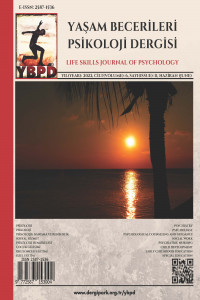Çevrimiçi Sosyal Etkileşimin Ergenlerin İnternet Bağımlılığı Üzerindeki Etkisi
Çevrimiçi Sosyal Etkileşim, İnternet Bağımlılığı, Ergenlik
The Influence of Online Social Interaction on Internet Addiction Among Adolescence
Online Social Interaction, Internet Addiction, Adolescence,
___
- Caplan, SE (2003). Preference for online social interaction: A theory of problematic Internet use and psychosocial well-being. Communication Research, 30(6), 625-648.
- Chou, W.J., Liu, T.L., Yang, P., Yen, C.F., & Hu, H.F. (2015). Multi-dimensional correlates of internet addiction symptoms in adolescents with attention-deficit/hyperactivity disorder. Psychiatry Research, 225(1-2), 122-128.
- Indonesian Internet Service Providers Association. (2017). Survey Results and Behavior of Indonesian Internet Users 2017. Retrieved from apjii.or.id/surveys.
- Jiang, Q. (2014). Internet addiction among young people in China: Internet connectedness, online gaming, and academic performance decrement. Internet Research, 24(1), 2-20.
- Kuss, D.J, & Griffiths, M.D. (2011). Online social networking and addiction-a review of the psychological literature. International Journal of Environmental Research and Public Health, 8(9), 3528-3552.
- Lee, Y.H., Ko, C.H., & Chou, C. (2015). Re-visiting internet addiction among Taiwanese students: A cross-sectional comparison of students' expectations, online gaming, and online social interaction. Journal of Abnormal Child Psychology, 43(3), 589-599.
- Mesch, G.S. (2012). Technology and youth. New Directions for Youth Development, 135, 97-105.
- Morahan-Martin, J. (2007). Internet use and abuse and psychological problems. In Oxford handbook of internet psychology .
- Morahan-Martin, J. (2008). Internet abuse: Emerging trends and lingering questions. Psychological Aspects of Cyberspace: Theory, Research, Applications, 32.
- Müller, K.W., Dreier, M., Beutel, M.E., Duven, E., Giralt, S., & Wölfling, K. (2016). A hidden type of internet addiction? Intense and addictive use of social networking sites in adolescents. Computers in Human Behavior, 55, 172-177.
- Neto, F., & Barros, J. (2000). Psychosocial concomitants of loneliness among students of Cape Verde and Portugal. The Journal of Psychology, 134(5), 503-514.
- Rosenbaum, M.S., & Wong, I.A. (2012). The effect of instant messaging services on society's mental health. Journal of Services Marketing, 26(2), 124-136.
- Smahel, D., Brown, B.B., & Blinka, L. (2012). Associations between online friends and Internet addiction among adolescents and emerging adults. Developmental Psychology, 48(2), 381.
- Tao, R., Huang, X., Wang, J., Zhang, H., Zhang, Y., & Li, M. (2010). Proposed diagnostic criteria for internet addiction. Addiction, 105(3), 556-564.
- Wee, C.-Y., Zhao, Z., Yap, P.-T., Wu, G., Shi, F., Price, T., ... Shen, D. (2014). Disrupted brain functional network in internet addiction disorder: A resting-state functional magnetic resonance imaging study. PloS One, 9(9), e107306.
- Yao, M.Z., He, J., Ko, D.M., & Pang, K. (2014). The influence of personality, parental behaviors, and self-esteem on Internet addiction: A study of Chinese college students. Cyberpsychology, Behavior, and Social Networking, 17(2), 104-110.
- Ybarra, M.L., & Mitchell, K.J. (2005). Exposure to Internet pornography among children and adolescents: A national survey. Cyberpsychology & Behavior, 8(5), 473-486.
- Young, K.S., & De Abreu, C.N. (2010). Internet addiction: A handbook and guide to evaluation and treatment. John Wiley & Sons.
- Young, K.S., & Rogers, R.C. (1998). The relationship between depression and Internet addiction. Cyberpsychology & Behavior, 1(1), 25-28.
- ISSN: 2587-1536
- Başlangıç: 2017
- Yayıncı: Muhammed YILDIZ
Çevrimiçi Sosyal Etkileşimin Ergenlerin İnternet Bağımlılığı Üzerindeki Etkisi
Putra Hidayat, Siti Rohmah Nurhayati
Bir Freud Masalı: Çocuk Masumluğu
Seda ORAL, Şahide Güliz KOLBURAN
Gözden Geçirilmiş A Erteleme Ölçeği-15 Formunun Geliştirilmesi ve Faktör Yapısının İncelenmesi
Arkun TATAR, Gaye SALTUKOĞLU, Hüdanur ÖZDEMİR
Cinsel İşlev Bozuklukları ve Depresyon
Üniversite Öğrencilerinde Yeme Bozukluğu Riskinin Lojistik Regresyon ile Belirlenmesi
Seda KERMEN, Umut KERMEN, Feyza DİNÇER, Mücahit MUSLU
(Özellik) Empatik Öfke Ölçeği'nin Türkçe Geçerlik ve Güvenirlik Çalışması
Evli Bireylerin Evlilik Değerleri Evlilik Doyumu ve Evlilik Tipleri
Meliha TEKİN ÇATAL, Melek KALKAN
Yetişkinlerin Ruhsal Hastalığa/Hastalara Yönelik Tutumları
Adile TÜMER, Sevilay HEBCAN ÖRS, Havva AKPINAR
Anksiyete Bozukluklarının Tedavisinde İnternet Tabanlı Bilişsel Davranışçı Terapi Uygulamaları
